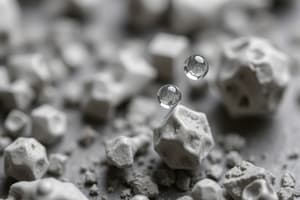Podcast
Questions and Answers
What does Dalton’s Atomic Theory state about elements?
What does Dalton’s Atomic Theory state about elements?
- All elements are composed of molecules.
- All atoms of different elements are identical.
- Atoms can be created and destroyed in reactions.
- Each element is composed of atoms. (correct)
Dalton's Atomic Theory states that all atoms of a given element are chemically identical.
Dalton's Atomic Theory states that all atoms of a given element are chemically identical.
True (A)
What law states that mass is neither created nor destroyed in chemical reactions?
What law states that mass is neither created nor destroyed in chemical reactions?
Law of Conservation of Mass
The law of _________ states that when two elements form different compounds, the ratios of the masses of the second element that combine with a fixed mass of the first element can be expressed in small whole numbers.
The law of _________ states that when two elements form different compounds, the ratios of the masses of the second element that combine with a fixed mass of the first element can be expressed in small whole numbers.
Match the following concepts to their descriptions:
Match the following concepts to their descriptions:
What is the correct approach to balance the equation $a H_2 + b O_2 \rightarrow c H_2O$?
What is the correct approach to balance the equation $a H_2 + b O_2 \rightarrow c H_2O$?
Changing coefficients in a chemical equation affects the actual substances involved.
Changing coefficients in a chemical equation affects the actual substances involved.
What is the key condition for balancing coefficients in a chemical equation?
What is the key condition for balancing coefficients in a chemical equation?
To balance a chemical equation, you should change the ______ but not the ______.
To balance a chemical equation, you should change the ______ but not the ______.
Match the term with its definition:
Match the term with its definition:
What is the smallest unit of an element?
What is the smallest unit of an element?
Pure substances can have varying compositions from sample to sample.
Pure substances can have varying compositions from sample to sample.
Name a characteristic of a homogeneous mixture.
Name a characteristic of a homogeneous mixture.
A mixture that consists of two or more pure substances that is not uniform is known as a __________ mixture.
A mixture that consists of two or more pure substances that is not uniform is known as a __________ mixture.
Which of the following is an example of a homogeneous mixture?
Which of the following is an example of a homogeneous mixture?
Match the following terms with their definitions:
Match the following terms with their definitions:
Chemical changes that describe how substances react are known as __________.
Chemical changes that describe how substances react are known as __________.
All substances with the same physical appearance are necessarily homogeneous mixtures.
All substances with the same physical appearance are necessarily homogeneous mixtures.
Match the following key areas to their relevance in engineering:
Match the following key areas to their relevance in engineering:
What is the formula weight (FW) of water (H2O)?
What is the formula weight (FW) of water (H2O)?
The empirical formula is used to determine molecular weight for ionic solids.
The empirical formula is used to determine molecular weight for ionic solids.
What does FW stand for in chemistry?
What does FW stand for in chemistry?
The molecular weight of H2O is ____ u.
The molecular weight of H2O is ____ u.
What is the correct way to write the formula for sodium chloride?
What is the correct way to write the formula for sodium chloride?
Molecular weight (Mw) and formula weight (FW) are different concepts.
Molecular weight (Mw) and formula weight (FW) are different concepts.
How many grams of O2 can react with 2.00 g of H2?
How many grams of O2 can react with 2.00 g of H2?
Match the following chemical terms with their definitions:
Match the following chemical terms with their definitions:
Flashcards
Moodle
Moodle
The digital platform used to provide all course information for Chemistry.
Chemistry: The Central Science in SI Units
Chemistry: The Central Science in SI Units
The assigned textbook for Chemistry.
Office Hours
Office Hours
Regular sessions where students can ask questions and get help with the material.
Prof. David J. Norris
Prof. David J. Norris
Signup and view all the flashcards
Thursdays, 17:00-18:00
Thursdays, 17:00-18:00
Signup and view all the flashcards
0.25 point bonus on final grade
0.25 point bonus on final grade
Signup and view all the flashcards
PS #1
PS #1
Signup and view all the flashcards
Friday, Sept. 27, 14:00
Friday, Sept. 27, 14:00
Signup and view all the flashcards
MAVT Engineers and Chemistry
MAVT Engineers and Chemistry
Signup and view all the flashcards
Why Chemistry for Engineers?
Why Chemistry for Engineers?
Signup and view all the flashcards
MAVT and the Regret of Neglecting Chemistry
MAVT and the Regret of Neglecting Chemistry
Signup and view all the flashcards
Goals of the Introductory Chemistry Course
Goals of the Introductory Chemistry Course
Signup and view all the flashcards
Engaging Students in Chemistry
Engaging Students in Chemistry
Signup and view all the flashcards
Lifelong Learning in Chemistry
Lifelong Learning in Chemistry
Signup and view all the flashcards
Experts: Continuous Learning
Experts: Continuous Learning
Signup and view all the flashcards
Tutorials in Early Exercises
Tutorials in Early Exercises
Signup and view all the flashcards
What is an atom?
What is an atom?
Signup and view all the flashcards
Elements
Elements
Signup and view all the flashcards
Molecules
Molecules
Signup and view all the flashcards
Compounds
Compounds
Signup and view all the flashcards
Chemical Reactions
Chemical Reactions
Signup and view all the flashcards
Pure Substances
Pure Substances
Signup and view all the flashcards
Homogeneous Mixture
Homogeneous Mixture
Signup and view all the flashcards
Heterogeneous Mixture
Heterogeneous Mixture
Signup and view all the flashcards
What is Dalton's Atomic Theory?
What is Dalton's Atomic Theory?
Signup and view all the flashcards
What makes atoms of different elements unique?
What makes atoms of different elements unique?
Signup and view all the flashcards
Are all atoms of the same element the same?
Are all atoms of the same element the same?
Signup and view all the flashcards
What happens to atoms in chemical reactions?
What happens to atoms in chemical reactions?
Signup and view all the flashcards
How are compounds formed?
How are compounds formed?
Signup and view all the flashcards
What are chemical equations?
What are chemical equations?
Signup and view all the flashcards
What are coefficients in chemical equations?
What are coefficients in chemical equations?
Signup and view all the flashcards
What does it mean to balance a chemical equation?
What does it mean to balance a chemical equation?
Signup and view all the flashcards
What are chemical reactions?
What are chemical reactions?
Signup and view all the flashcards
What are subscripts in chemical formulas?
What are subscripts in chemical formulas?
Signup and view all the flashcards
Formula Weight (FW)
Formula Weight (FW)
Signup and view all the flashcards
Molecular Weight (Mw)
Molecular Weight (Mw)
Signup and view all the flashcards
Empirical Formula
Empirical Formula
Signup and view all the flashcards
Study Notes
Chemistry Lecture 1 Notes
- The lecturer is Prof. David J. Norris
- Email: [email protected]
- Office: LEE P210
- Office hours: Thursdays 17:00-18:00 or by appointment
- The course uses American English
- Chalkboard and slides will be used for teaching
- Lecturer is from Chicago
- Teaching assistants are listed on page 2
- All course information is available on Moodle: https://moodle-app2.let.ethz.ch/course/view.php?id=22903
- Textbook: Chemistry: The Central Science in SI Units, 15th Edition, ©2022, by Theodore E. Brown, et al.
- Exercises are held Fridays 14:00-16:00
- Problem sets are weekly, and 3 are randomly graded
- Pass 2 out of 3 problem sets for bonus
- Problem set 1 is due Friday, Sept. 27, 14:00
- Required textbook is available in the ETH Store (Orell Füssli) and online.
- ISBN: 978-1-292-40761-6
- Price: CHF 88.90
Why Chemical Knowledge is Important
- Some engineering students initially underestimate the need for chemistry
- Many fields of engineering rely on chemistry, including mechanical and process engineering
- Students are urged to develop strong chemical knowledge
- Students may regret skipping basic chemistry
- Chemical knowledge is crucial in important engineering and technological areas including, but not limited to:
- batteries
- Hydrogen-fired turbines
- Carbon capture
- Transportation
- Biomedical devices
Goals for the Course
- Introductory chemistry course designed for engineering students
- Goal of the course is to provide a foundation in basic chemistry
- The lecturer wants to engage all students, even experts
Your Challenge
- The lecturer expects students to ask questions
- The lecturer will do everything possible to clarify any questions
- Students should stay engaged during the lecture and in doing the exercises/problem sets
Apologies in Advance
- There may be some handwriting-related problems with the lecture slides
- German translations to specific lecture slides/exercises can be requested if necessary
- Students can provide feedback
Lecture Content - What is Chemistry, Atoms, and the Periodic Table
-
Chemistry is defined as the study of matter and its properties and behavior
-
Elements are substances made up of one type of atom
-
Molecules are made from atoms of different elements
-
Compounds contain atoms from different elements joined together
-
The study of chemical changes forms the heart of chemical reactions (and this is distinct from physical changes, like melting ice)
- During chemical reactions, energy is either absorbed or released
- Atoms are neither created nor destroyed during chemical reactions (this is important)
-
Atoms are composed of smaller particles
-
Protons, neutrons, and electrons are the main subatomic particles and have different properties each
-
Structure of the atom has the nucleus at the center with electrons circulating
-
Atoms in an element are identical chemically
-
Atoms from different elements combine to produce compounds
-
Periodic table organizes elements by atomic number (that determines the properties, and it is often already in order)
-
The number of protons determines the type of atom, and also the behaviour
- elements in the same column (group) of the periodic table display similar properties
More Lecture Content
- Chemical equations describe chemical changes
- Atom types must be balanced on the reactant and product sides
- Some important laws of chemical reactions are constant composition, conservation of mass, and multiple proportions.
- Definition and examples of Polyatomic ions
- Names and formulas for important cations and anions are essential in naming and understanding ionic compounds.
Further Lecture Content:
- The mole is a standard that equals 6.02 x 1023
- The atomic mass of an element expressed in grams contains one mole of atoms.
- Formula weight is sum of the atomic weights of the atoms in a molecule
- The concept of molar mass is defined as grams per mole, and molar mass is determined from the molecular formula
Studying That Suits You
Use AI to generate personalized quizzes and flashcards to suit your learning preferences.




